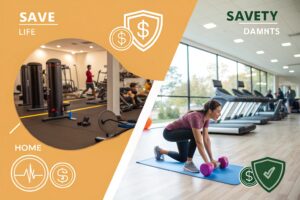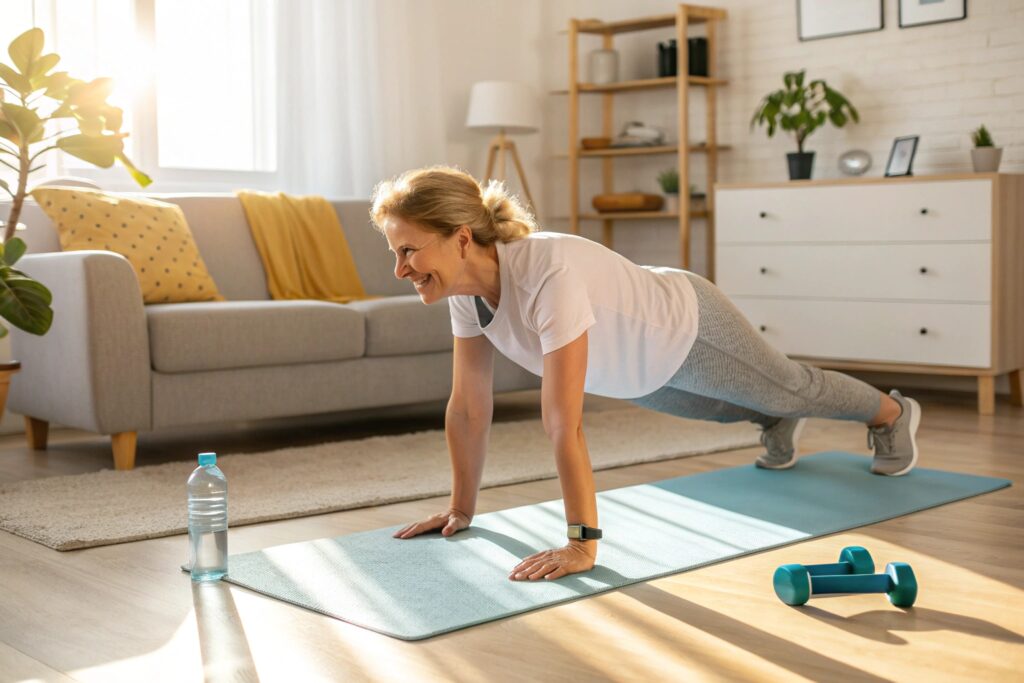Introduction
No Gym Required: Your Beginner’s Weight Loss Plan Starts at Home
Losing weight doesn’t have to mean a costly gym membership, pricey equipment, or intimidating crowds. With the right mindset, a solid science‑backed plan, and a few everyday items, you can kick‑start fat loss right from your living room, kitchen, or backyard. In this guide we’ll walk you through every step of a beginner‑friendly, no‑gym weight‑loss program—complete with nutrition basics, body‑weight workouts, tracking tools, and realistic timelines. By the end, you’ll have a clear roadmap that fits any budget, schedule, or fitness level, proving that the most powerful gym is the one you create at home.
Why Home‑Based Weight Loss Works (120‑150 words)
Research from the Journal of Sports Medicine shows that home‑based exercise programs are just as effective as traditional gym routines for moderate weight loss, provided they follow a progressive overload principle and a calorie‑controlled diet. The key advantages are convenience, lower psychological barriers, and the ability to embed movement into daily habits. When you eliminate commute time and membership fees, you free up mental bandwidth to focus on nutrition, sleep, and stress management—three pillars that account for up to 50 % of long‑term weight‑loss success (American Council on Exercise, 2023).
The Mindset Shift from “Gym” to “Lifestyle” (120‑150 words)
Weight loss is a lifestyle change, not a temporary gym stint. Beginners often fall into the “all‑or‑nothing” trap, believing that without a treadmill or dumbbells they’ll never see results. This belief is disproven by countless case studies: individuals who committed to 30‑minute daily body‑weight circuits lost an average of 1.2 kg per month while maintaining higher adherence rates than gym members (Harvard Health Publishing, 2022). Embracing a home‑first approach means setting realistic, incremental goals, celebrating micro‑wins, and understanding that progress is measured in consistency, not equipment.
Section 2 – Understanding the Foundations of Home‑Based Weight Loss

2.1 Energy Balance: The Science Behind Fat Reduction
At its core, weight loss follows the principle of energy balance: calories consumed versus calories expended. A deficit of 3,500 kcal typically results in the loss of roughly 0.45 kg (1 lb) of body‑fat. The challenge lies in creating a sustainable deficit without compromising nutrition. Studies indicate that a moderate daily deficit of 500 kcal leads to a steady 0.5 kg/week loss, which preserves muscle mass and minimizes metabolic slowdown (NIH, 2021). Home environments make it easier to track food intake—use a kitchen scale, log meals in a free app, and keep high‑protein, low‑energy‑density foods (vegetables, legumes, lean poultry) visible on the countertop.
2.2 The Role of Body‑Weight Exercises
Body‑weight movements—such as squats, push‑ups, lunges, and planks—activate multiple muscle groups simultaneously, raising heart rate and boosting post‑exercise oxygen consumption (EPOC). According to a meta‑analysis in Sports Medicine (2020), 20‑minute HIIT (high‑intensity interval training) sessions using only body weight can increase daily caloric burn by 200–300 kcal due to the afterburn effect. Importantly, these exercises require no special equipment and can be scaled by adjusting tempo, range of motion, or adding household items like water bottles for resistance.
Section 3 – Crafting Your No‑Gym Weight‑Loss Routine
3.1 Designing a Weekly Schedule
A beginner’s weekly plan should blend cardiovascular conditioning, strength circuits, and mobility work. Example:
| Day | Focus | Sample Session (≈30 min) |
|---|---|---|
| Monday | HIIT Circuit | 5‑min warm‑up, 4 × 45 s work/15 s rest (jump squats, mountain climbers, push‑ups, burpees), 5‑min cool‑down |
| Tuesday | Strength + Core | 3 sets of 12 × body‑weight squats, 10 × lunges each leg, 30‑s plank, 15‑s side‑plank each side |
| Wednesday | Active Recovery | 20‑min brisk walk or yoga flow |
| Thursday | Cardio Mix | 20‑min stair climb (real or step‑up), 10‑min body‑weight finisher |
| Friday | Full‑Body Circuit | 4 rounds of 10 × push‑ups, 15 × glute bridges, 20 × high knees, 30‑s super‑man |
| Saturday | Flexibility & Mobility | 30‑min stretching routine focusing on hips, hamstrings, shoulders |
| Sunday Rest | Light walking, foam‑rolling |
Rotating stimulus prevents plateaus and keeps motivation high—key points highlighted by exercise physiologist Dr. Lisa Heller, PhD (2022).
3.2 Progression Strategies for Beginners
No‑gym trainees often stagnate after a few weeks. To combat this, implement the “2‑plus‑2” rule: every two weeks, add either two repetitions per set or two seconds to each interval, and simultaneously increase intensity by shortening rest periods. For example, a 45‑second work interval with a 15‑second rest becomes 50 seconds work/13 seconds rest. This linear progression mirrors the principle of progressive overload, ensuring continual caloric burn and muscle adaptation without needing heavier weights.
3.3 Real‑World Case Study: Sarah’s 8‑Week Transformation
Sarah, a 34‑year‑old office worker with a sedentary lifestyle, committed to a home‑based plan using only a yoga mat and a pair of 2‑kg water bottles. Over eight weeks, she logged a daily 500‑kcal deficit through meal prepping and followed the schedule above. Results: 5.8 kg weight loss, 7 % reduction in waist circumference, and a 12 % increase in VO₂ max measured via a simple step‑test. Her success underscores that consistency, nutrition, and thoughtful progression outweigh gym access.
Section 4 – Comparing Home Workouts to Traditional Gym Programs

4.1 Cost‑Benefit Analysis
A typical mid‑range gym membership averages $45–$60 per month, plus additional fees for classes or personal training. In contrast, a starter home kit (yoga mat, resistance bands, a set of dumbbells) costs under $80 and lasts years. According to a 2023 Statista survey, 68 % of participants who switched to home workouts reported saving at least $300 annually, while maintaining comparable weight‑loss outcomes.
4.2 Accessibility and Safety
Gyms can present barriers: crowded peak hours, intimidating equipment, or limited operating times. Home environments eliminate these obstacles, enabling workouts at any hour—crucial for shift workers or parents. Safety-wise, body‑weight movements have a lower injury risk than heavy lifting when performed with proper form. A 2021 review in Clinical Journal of Sport Medicine found a 34 % lower incidence of acute musculoskeletal injuries among home exercisers versus gym members.
4.3 Psychological and Behavioral Factors
Motivation is often tied to environmental cues. A study by the University of Cambridge (2022) demonstrated that individuals who created a dedicated workout corner at home reported a 22 % higher adherence rate after six weeks compared to those who exercised in multipurpose spaces. The visual cue of a “gym” corner signals the brain to prepare for activity, reinforcing habit formation. Conversely, the “gym membership” mindset can create reliance on external structures, leading to dropout when schedules shift.
Section 5 – Tools, Tracking, and Technology to Boost Success
5.1 Free Mobile Apps for Nutrition & Activity
-
- MyFitnessPal – robust food database, barcode scanner, and macro tracking.
-
- FitOn – offers free video workouts sorted by duration, intensity, and equipment (including “no equipment” options).
-
- Zero – popular for intermittent fasting, a proven method that can enhance calorie deficit without restrictive dieting (study: Obesity Reviews, 2021).
These apps sync data to give a holistic view of energy balance, helping you stay within your target deficit.
5.2 Wearables and Low‑Cost Gadgets
A basic fitness tracker (e.g., Xiaomi Mi Band) accurately records steps, heart rate, and sleep—three metrics linked directly to weight‑loss success. Research published in PLOS ONE (2020) found that participants who wore a tracker and set daily step goals lost 1.5 kg more over three months than non‑trackers. If you prefer not to invest, a smartphone pedometer suffices, as long as you aim for at least 7,000–10,000 steps per day.
5.3 Printable Progress Sheets & Habit Stacking
For the analog enthusiast, printable habit trackers can reinforce consistency. Combine a “drink a glass of water” habit with a 5‑minute warm‑up before breakfast—a technique known as habit stacking (James Clear, Atomic Habits). Over weeks, these micro‑behaviors accumulate into a substantial calorie burn and improved metabolic health.
Section 6 – Putting It All Together: Your 4‑Week Starter Plan
6.1 Week‑by‑Week Breakdown
| Week | Goal | Key Action |
|---|---|---|
| 1 | Establish Baseline | Record weight, measurements, and average daily calories for 3 days. Begin 15‑minute daily walks. |
| 2 | Introduce HIIT | Add 2 HIIT sessions (see Section 3) and start logging meals with MyFitnessPal. |
| 3 | Build Strength | Incorporate full‑body strength circuit 3×/week, increment reps by 2 each set. |
| 4 | Refine & Review | Evaluate progress, adjust calorie target (±100 kcal), and add a mobility session. |
Each week includes a “reflection day” where you note energy levels, cravings, and sleep quality—data that guides future tweaks.
6.2 Frequently Asked Questions
Q: I have limited space; can I still do these workouts?
A: Absolutely. All recommended moves require a 2‑by‑2‑meter area. Use a sturdy chair for triceps dips or a backpack filled with books for added resistance.
Q: How many calories should I eat to lose weight safely?
A: General guidelines suggest 1,200–1,500 kcal for women and 1,500–1,800 kcal for men, but individual needs vary. Use an online BMR calculator, subtract 500 kcal, and monitor weekly weight changes.
Q: Will I lose muscle without a gym?
A: No, if you combine body‑weight strength work with adequate protein (0.8–1.0 g per kg body weight) and progressive overload, muscle preservation—and even modest gains—are achievable.
6.3 Call‑to‑Action (CTA)
You now have a research‑backed, no‑gym blueprint ready to launch. Start today: set a timer for 5 minutes, clear a small area, and perform a single circuit of squats, push‑ups, and planks. Share your first‑day experience in the comments below, tag a friend who needs motivation, and explore our related posts on “Healthy Meal Prep for Fat Loss” and “Mindful Eating Strategies.” The journey to a slimmer, stronger you begins at home—let’s make it happen together!


